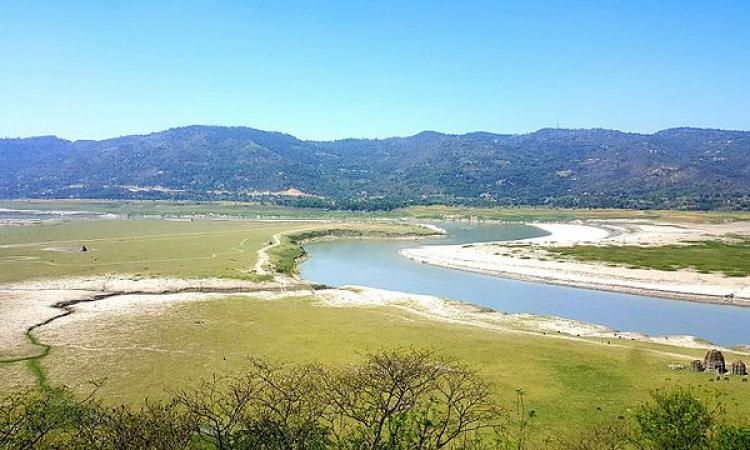
River Satluj, the powerhouse of the Himalayas
The river Satluj, a major source of irrigation and hydroelectric power in Northern India, is the longest of the five tributaries of the Indus River. It originates in the northern slopes of the Himalayas, in Lake La’nga in southwestern Tibet. Flowing northwest and then west-southwest through the Himalayan gorges, it enters and crosses the Indian states of Himachal Pradesh and Punjab and then continues southwest, joining the Beas River and forming 105 kilometres of the India-Pakistan border before entering Pakistan.
The Satluj, along with its tributaries, is often referred to as the powerhouse of the Himalayas. A number of hydroelectric power projects are being planned on the river in the state of Himachal Pradesh. The overall hydroelectric power capacity in Himachal Pradesh is around 20,000 megawatts (MW), of which around 50% is from the Sutlej valley.
At Bhakra, Himachal Pradesh, a major dam on the Satluj utilises water from the river for hydroelectricity generation and irrigation. The Bhakra reservoir has a capacity of 9340 million cubic metres and receives 65–80% of its inflow from the Satluj river, and the remaining 20 to 35% from the Beas river. The Satluj supports the generation of 4566 MW of hydropower, with potential for future expansion and a number of new hydroelectric projects being planned on the river.
Flows of Satluj could be under threat
The hydrology of the Sutlej is controlled by spring and summer snowmelt in the Himalayas and by the South Asian monsoon. More than 50% of the annual flow of Satluj river comes from snow and ice melt.
The Satluj basin has 2,026 glaciers of different sizes. The headwaters of the river consist of a glaciated area of 1426 square kilometres.
However, the flow of the river could be drastically altered in the coming years, according to this study - ‘Large losses in glacier area and water availability by the end of twenty-first century under high emission scenario, Satluj basin, Himalaya’ published in Current Science.
The study argues that water reserves in the river that are dependent on the glaciers are likely to be altered considerably in the future due to climate change, as glaciers are highly sensitive to variations in temperature and precipitation. Recent observations show that near-surface air temperatures in the North Western Himalayas have increased by 0.65°C between 1991 and 2015, as compared to the mean global temperature rise of 0.47°C. This has negatively influenced the mass and area of glaciers in the region, which are now at risk of shrinking, thus affecting water availability in the region.
The study assessed the response of Satluj basin glaciers to the changes in precipitation and temperature from 1984 to 2090. The amount of water locked in the glaciers was calculated using different techniques, while changes in the behaviour of the glaciers were predicted by using climate projection models. The future projected contribution of glacier melt to the Bhakra reservoir were also estimated.
The study found that:
Glacier loss already started in the basin could worsen further
The total glacier stored water for 2026 glaciers in Satluj basin was 69 cubic kilometres. About 56% of the total volume (37 cubic kilometres) was stored in large glaciers (with an area of above 5 sq. km) covering an area of 517 sq km. The largest glacier found in the study area was from the Tibetan region, which was found to occupy an area of 66.8 sq. km and contained 6.5 gigatonne (Gt) of ice. Most of the glaciers contained less than 0.1 Gt of ice.
The study found that the Satluj basin has already lost 21% (16.4 Gt) of glacier volume between 1984 and 2013, which could further worsen with projected temperature rise and decrease in precipitation in the region due to climate change.
Higher temperatures and less rainfall will continue
Climate modelling showed that there will be a projected rise in summer temperatures by 3.7°C by 2050 and by 7.94°C by 2090 respectively. The projections also show that there will be a decrease in winter snowfall by 14% by 2050 and by 5% by the year 2090. Most glaciers in the Satluj basin could disappear in less than a century. Around 55% of the glaciers in Satluj basin are likely to disappear by 2050, and by 2090 only 3% of the total glaciers will remain.
Glacial melt will be higher for smaller glaciers (area <1 sq. km) because of the shorter response time of small glaciers, making them more vulnerable to climate change. Glaciers with area less than 1 sq. km will experience approximately 62% of area loss by 2050, while bigger glaciers (area >10 sq. km) show a slower response to climate change with only 1% loss in their area.
Glacier melt will hit water availability in the region severely
This continuous glacier loss will affect downstream water availability in the region, and will also contribute to melt runoff to the Bhakra reservoir. The contribution from glacier melt will increase in the initial period, being the highest at around 2050, and will reduce thereafter.
The paper highlights, “The disappearance of smaller glaciers located at lower elevation will change the pattern and overall availability of water to the various hydropower projects located in the downstream areas of the basin, thereby posing new challenges for the smaller communities in the Himalayan region”.
It will also increase the occurrence of disasters such as glacier lake outburst floods. The study calls for the need to urgently improve the existing water management practices in the region and make urgent and concerted efforts to improve resilience of mountain communities to climate change.
The paper can be accessed at this link